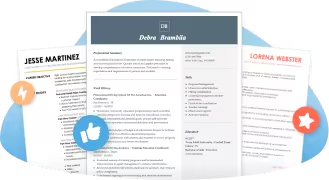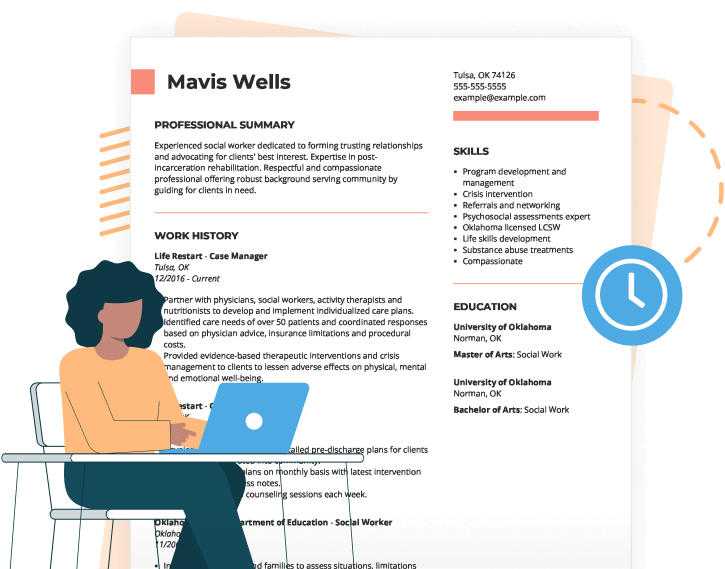Featured Resume Examples
Our other top-requested aviation resume examples are for pilot, aircraft mechanic and air traffic controller. Want different aviation roles? Scroll down, there’s more below!
Search Aviation Jobs
Roles in Aviation By Type
Find the resume example you need by browsing these specific Aviation categories:
Customer Service Roles (11)
Engineering Roles (2)
Flight Coordination Roles (2)
Management and Leadership Roles (3)
Piloting Roles (5)
Technical Roles (9)
Cover Letters
Job Outlook
Buckle up! The aviation industry is taking flight this upcoming decade.
According to the U.S. Bureau of Labor Statistics, flight attendants’ employment rate will grow 17% in the next couple of years. This is due to the fact that many airlines are now using large planes, increasing the number of crew members on board.
Likewise, overall employment of airline pilots, copilots and flight engineers will go up by 3% until 2029, while commercial pilots will be hired at a much faster rate than other occupations and employment is projected to grow 9%.
Air traffic controllers will also experience growth at 1%. This increase is slower in comparison to the other occupations, making it a competitive area to enter.
Let’s make sure you have a resume that, whatever the role, gets you where you want to be.
3 Tips for Writing Aviation Resumes
Choose the right format for your aviation resume
The first step to creating a great resume is to understand the three resume formats. Each of them organizes your information differently and the way you choose which one works best for you comes down to your years of experience.
Let’s imagine different scenarios.
You’re a pilot with over five years of work experience and want to apply to a new airline. In this case, the chronological resume is the one for you because it focuses on showing off your extensive work history and career progression — so how you went from a rookie to someone very experienced.
But maybe you are just starting out — a check-in agent with less than two years of experience. The most suitable option for you is the functional resume. Instead of focusing on your sparse work history, it focuses on your skills, education and the qualifications that make you an excellent candidate.
In-between these two is the flight attendant with a good three to five years of experience. They know how to do their job, but they still have room for growth. For them, we recommend the hybrid format.
This resume format works just as its name suggests. It’s a combination of the chronological and functional resume because it evenly shows your work history chronologically and the skills you possess, as well as the professional skills you’ve learned through the years.
Now that you know the three resume formats, it’s time to choose one. Doing so now will save you a lot of time and move you to the next step faster.
Promote sought-after resume skills
With the right resume format chosen, it’s now time to decide what skills will go on your resume.
We know that every aviation role has its set of requirements and responsibilities, but every hiring manager likes to see a couple of these skills in their candidates.
Check out the list below and see which ones apply to you:
- Attentiveness
- Strong communication
- Problem-solving
- Quick thinking
- Physical stamina
- Organization
- Safety focused
- Team player
- Mathematics
- Physics
- Decisiveness
- Diplomatic
- Friendly
- Flexibility
- Adaptability
- Empathetic
- Cultural awareness
- Attention to detail
- Stress tolerance
- Time management
- Ability to work in emergencies
- First Aid administration
- Documentation
- Cordiality
- Situational awareness
- Good depth perception
- Quick reaction time
- Responsible
- FAR 135 experience
- EC-135 knowledge
- ATP rating
- IFR experience
- Analytical
- Flight plans creation
- Ability to operate equipment
- Traffic flow management
- Flight service station
- Air traffic scenario development
- FAA knowledge
- Project management
- TBFM expertise
- ERAM proficiency
- IDSR knowledge
Show the hiring manager you’re the best candidate for the job by including about six to eight of these skills in your resume.
Use a template to make your resume look modern
Aviation is an attractive industry that has garnered people’s interest for many decades. Show hiring managers you’re the perfect addition to the team by creating a resume that captures your experience.
At JobHero, we have a huge selection of modern and clean resume templates for you to make your own. It’s as simple as adding your information.
Our Resume Builder is a time-saver and extremely user-friendly. It suggests keywords, marks possible spelling mistakes, and lets you organize your information any way you want.
Once you’re done, you can save it and let it soar to different job postings.
FAQ
How much do people get paid in aviation?
The numbers are good! Aviation offers an above-average salary across the board.
According to the U.S. Bureau of Labor Statistics, airline pilots, copilots and flight engineers can earn an annual salary of about $147,200. Simultaneously, air traffic controllers can make $122,990 or more, depending on where they work and the complexity of the flight paths.
Meanwhile, flight attendants have a median annual wage of $56,640 and many perks, like discounted airfare and free standby seats through their airline.
If this is the industry for you, don’t miss out on being a part of it — use our Resume Builder to create a first-class resume.
What are the duties and responsibilities in aviation?
The specific duties and responsibilities will vary by job.
Some aviation industry professionals will be in charge of piloting an aircraft, while others, such as flight attendants, will work directly with clients during a flight to ensure their comfort and safety.
There are also aircraft engineers, whose main job is to create the aircraft and propulsion systems, and aircraft assemblers, who put together the aircraft.
Aviation is a large field where some people work behind the scenes while others are on stage, but every single role is important.
Can you work in aviation with no qualifications?
While there are entry-level positions, the Federal Aviation Administration requires candidates to possess specific certifications and licenses to work in aviation.
For example, flight attendants typically only need a high school diploma, but they must complete the three to six-week training provided by the airline to be certified. They must also pass a background check, have a valid passport and at least 20/40 vision.
Likewise, candidates who want to become air traffic controllers need an associate or bachelor’s degree from an AT-CTI program and complete several exams provided by the FAA.
The requirements to become a pilot are more rigorous, though.
While a commercial pilot usually only needs a high school diploma, an airline pilot needs to have a bachelor’s degree. All pilots must be licensed by the FAA.
Pilots train for six to eight weeks in accordance with Federal Aviation Regulations and receive their licenses and ratings in the following order:
- Student pilot certificate
- Private pilot license
- Instrument rating
- Commercial pilot license
- Multi-engine rating
- Airline transport pilot certificate
To gain each certification and rating, pilots must pass a written exam and a practical flying exam. In addition to passing these, candidates must have completed different hours of flight time.
Is it hard to work in aviation?
As you read above, candidates spend a lot of time training and passing exams to get the certifications and licenses required. It takes a lot of dedication to work in this field.
Different roles come with their own set of challenges, especially when the unexpected happens. A pilot must know how to handle an emergency to get everyone to safety, a flight attendant must be patient and help the passengers remain calm, and an air traffic controller must know how to work as a guide from the ground.
It can be mentally and physically exhausting to work in aviation, but the professionals who have made it their career are incredibly passionate about it. They love the skies, love getting people to their destinations, and find comfort among the clouds.
Should I include a cover letter with my aviation resume?
Definitely!
Even if the job posting doesn’t say anything about a cover letter, do it anyway. It will help you look more professional and thorough to the hiring manager.
We always advise job seekers to submit one alongside the resume because a cover letter gives you the chance to talk more about yourself. You can further discuss your skills, work experience and highlight achievements, like how you helped a passenger during a flight because they were anxious, or a time where you made a successful emergency landing.
Think of the cover letter as the wings that will help your resume fly higher and at JobHero, we know precisely how to help you build it.
Start by checking our great selection of aviation cover letter examples to get inspired.






